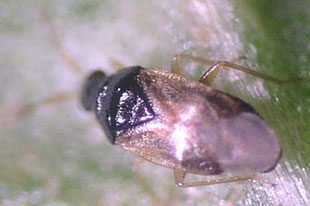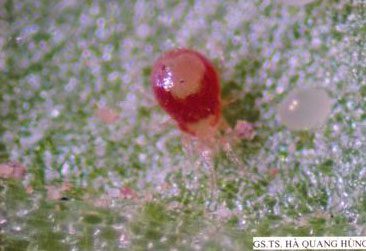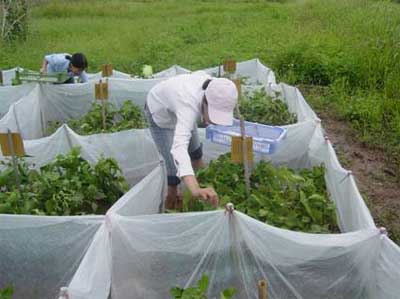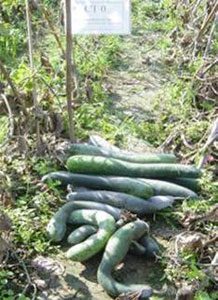 |
|
Predatory mite adult |
Scientists from the Entomology Department at the Hanoi University of Agriculture 1 have successfully implemented a breeding process for predatory mites that attack whiteflies and spider mites, as well as predatory bugs that target thrips.
This is considered a method using “natural enemies” to control harmful insects affecting crops. It has begun trials and has yielded high effectiveness in both yield and quality of agricultural products in the outskirts of Hanoi, with plans for broader application across various provinces in the country.
Currently, in Vietnam, harmful insect species such as red spider mites and thrips cause significant damage to crops including cucumbers, gourds, beans, oranges, lemons, flowers, peppers, tomatoes, roses, and many other plants. To combat these pests, farmers typically spray chemical pesticides nearly ten times during a planting season, but the effectiveness is often low, leading to environmental pollution and health risks for themselves and those nearby.
From Initial Successes
Reflecting on the practical effectiveness of this method of using insects to eliminate other pests, Vietnamese scientists acknowledge that using natural enemies for crop protection is a widely applied practice in many countries around the world, including China and the Netherlands, which has brought remarkable advances in agricultural production.
Many biotechnology companies, such as Koppert in the Netherlands, have mass-produced predatory mites and parasitic wasps, supplying them to farmers for release in fields and greenhouses where vegetables such as cucumbers, sweet peppers, tomatoes, strawberries, beans, and roses are grown. This has proven highly effective in controlling red spider mites, aphids, and whiteflies. The resulting vegetables, fruits, and flowers are very safe, as Dutch farmers do not need to use any chemical pesticides, a goal that has long been sought by Vietnamese scientists.

Adult predatory mite
Associate Professor Dr. Nguyen Thi Kim Oanh, who has spent time working and studying in the “land of tulips,” stated that biotechnology companies specializing in breeding predatory mites sell them to farmers. Depending on the area, the number of plants, and the density of harmful mites, the appropriate quantity of predatory mites is introduced to control pest populations.
Leveraging the natural conditions of agriculture in Vietnam, for the past two years, scientists from the Hanoi University of Agriculture 1 have been breeding predatory mites and bugs. Surveys show that the predatory mite species Amblyseius sp. is very common on crops harmed by small mites in Vietnam. Laboratory and field breeding results both indicate that this species has a high natural growth rate, a significant appetite for harmful mites, and is fully capable of controlling the populations of harmful red mites in nature. Notably, breeding predatory mites is quite favorable with the climate in the northern region from February to November each year.
The breeding facility for predatory mites is currently located temporarily in the Entomology Department’s experimental area. The breeding process is led by Associate Professor Dr. Nguyen Van Dinh, head of the Agronomy Department, and his research team. Specifically, they first plant beans in a clean environment. The most suitable food for breeding predatory mites is red spider mites. When the beans have produced six leaves, red spider mites are released at a ratio of 10 adults per plant. When the number of red spider mites reaches around 500 per plant, predatory mites are introduced at a rate of 2-3 per plant.

Testing predatory bugs against thrips harming cucumbers
Just seven to eight weeks later, the number of predatory mites increased 13 times compared to the initial density. At that point, both the predatory mites and their food are transported to areas where vegetables need protection. To ensure that predatory mites grow and develop quickly in environments with few red mites, scientists also use white spiders and several types of food such as pollen and honey to support the survival of predatory mites during storage and transport.
Predatory bugs of many species are being studied in various countries worldwide as natural enemies of many harmful insect species. In Vietnam, a group of scientists is also breeding the predatory bug Orius Sauteri to eliminate the small thrips that damage eggplants, gourds, green squashes, beans, cucumbers, and potatoes. Adult predatory bugs measure about 1.73-1.9 mm in length. The success of breeding predatory bugs is just one of many contributions not only from Professor Dr. Ha Quang Hung, who has nearly 40 years of teaching and research experience, but also from many educators in the Entomology Department. Professor Hung is recognized as a prominent entomologist, not only for his role as the General Secretary of the Vietnam Entomological Society and a member of the Executive Committee of the Vietnam Plant Protection Society, but also for being the author of many valuable practical scientific works.

Releasing predatory mites into bean fields
For the first time, cucumber farmers in Van Duc commune, Gia Lam, Hanoi, introduced predatory bugs to control the number of thrips, preventing thrip populations from exceeding harmful levels. Previously, farmers had to spray chemicals at least eight times, sometimes up to 13 times during a season to control thrips. The cucumbers experiencing “waist-twisting” and curving were all due to thrips attacks. The cucumber yield reached 208 kg per sao when using predatory bugs, equivalent to using chemical pesticides. The cost of using predatory bugs is comparable to buying pesticides, but farmers feel more at ease using them due to the health and ecological safety they provide.
On Mr. Nguyen Van Hung’s cucumber fields in the Dang Xa Cooperative, also in Gia Lam district, he used to frequently spray chemical pesticides for around 130,000 VND per sao. Mr. Hung noted that when he introduced predatory bugs to control thrips in his fields, the fruit yield did not drop compared to previous seasons, and it was certified as clean vegetables, allowing for higher selling prices.
Towards Clean Agricultural Products
For the past two years, the group of scientists has been manually breeding “natural enemies” under natural conditions without the need for extensive equipment. Their goal is not only to stop at a scientifically recognized topic by the Ministry of Science and Technology but also to develop the benefits it brings to Vietnam’s agricultural fields.
Compared to chemical spraying methods, using “natural enemies” seems relatively new and unfamiliar to farmers in our country. Currently, several companies are willing to act as “agents” for distributing this unique product. Meanwhile, the number of predatory mites and bugs bred does not meet the significant demand for crop protection today. The Hanoi University of Agriculture 1 is planning to invest in expanding its breeding facilities with modern equipment to continue researching and refining the breeding process, establishing a synchronized and continuous production line. According to Professor Dr. Ha Quang Hung, if the infrastructure for breeding is ensured, it would be possible to “release” batches of predatory mites or bugs to the fields every 19-20 days.
 |
| Curved cucumbers attacked by thrips |
Professor Hung has a habit of dedicating time during his business trips to “visit” fields while also “teaching” his students. In these “class sessions,” introducing new methods using “natural enemies” for crop protection to farmers seems to have become a responsibility for him and other scientists. Naturally, before applying this with each farmer, scientists must conduct thorough surveys on the fields, assess the spread and progression of harmful insects, and then evaluate and forecast pest risks. Integrated Pest Management (IPM) helps farmers implement specific measures for pest control or integrated pest management.
In the future, the development of breeding predatory spider and bug species will help reduce product costs to make them affordable for farmers, lowering them below the expenses of purchasing chemical pesticides. Regarding the encouragement of farmers to adopt this method, Associate Professor Dr. Kim Oanh emphasized: “When purchasing ‘natural enemies’ for pest control, farmers must receive a commitment from suppliers to ‘insure’ their crop products. At the same time, there should be a technical guidance plan to help them use these methods effectively in the fields.”
Predatory spiders can survive well when stored in 10ml plastic containers, along with corn core powder and food, making it convenient for their deployment in the fields. However, scientists are also seeking optimal methods to preserve and transport these ‘natural enemies’ to the fields and directly to farmers. Notably, using predatory spiders and bugs to control harmful mites and thrips is particularly suitable for crops grown in net houses or greenhouses, as these environments have fewer natural enemies and limited space.
It is known that if the breeding ‘chain’ of predatory spiders and bugs is perfected, scientists will collaborate with local Plant Protection Departments to implement it in safe vegetable growing areas. A clean vegetable development company in Hanoi, led by a Dutch national named Siber, will also be a regular customer purchasing these products to supply the clean vegetable fields in the two villages of Tằng My and Nam Hồng in Đông Anh District. The clean vegetable yield here, after harvest, is exported by the company to various countries in the region and around the world.
Building on the success of the breeding process for predatory spiders and bugs, scientists at the Hanoi University of Agriculture will conduct research on breeding other predatory insects and spiders, such as the goose-necked predatory bug (which feeds on larvae of scale insects that cause significant damage to vegetables)…
Many improved techniques have been implemented, such as Integrated Pest Management (IPM) and shaded houses, gradually meeting the increasing demand for safe vegetables from consumers. In light of the rapid development of global science and technology, the use of chemical pesticides for controlling harmful insects and mites must be minimized, and biological methods should be prioritized for investment to enhance production efficiency and the quality of agricultural products, contributing to the establishment of a clean and stable agricultural sector.
Trà My


















































